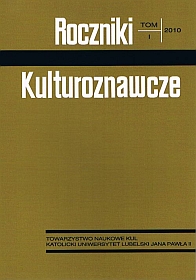Aesthetic and Moral Issue of the Theatre in the Writings of St. Augustine
Abstract
An analysis of texts indicates that in the mind of the author of the writings, the moral question the theatre poses is closely related to the issue of aesthetics. The evil the theater causes is explained by seducing pleasure, experienced as a result of touching scene, which disturbs the heart and weakens the will, leaving it defenseless against a sudden return of awakening instinct. The emotion comes from the desire of crying and human brotherhood. The Bishop of Hippo condemns the ancient theatre of his times for three main reasons: theological, moral and social. Theologically, the theatre seems to him to be a Devil’s playground and a morbid manifestation of an evil spirit. Morally, the theatre is a school of corruption. Socially, Augustine complains that the theater diverts the sight of people from the difficult real situation in the country, by a presentation of imaginary woes. We see in the Augustinian demonstration a great power of expression and an ability of psychological impact.
References
Bieber M.: Die Denkmäler zum Theaterwesen im Altertum. Leipzig: Vereinigung Wissenschaftlicher Verleger 1920.
Boissier G.: Minus. W: Dictionnaire de la mythologie Grecque et Romaine. Paris: PUF 1958.
Eckmann A., ks.: Dialog listowny św. Augustyna z Nektariuszem. „Roczniki Humanistyczne” 32:1984, z. 3 s. 57-94, zwłaszcza s. 80-83.
Friedlaender L., Wissowa G.: Darstellungen aus der Sittengeschichte Roms. Vol. 4. Leipzig: Hirzel 1932.
Hild J.H.: Flora. W: Dictionnaire de la mythologie Grecque et Romaine. T. 2. Paris: PUF 1958 s. 1189 n.
Jürgens H.: Pompa diaboli. Die lateinischen Kirchenväter und das antike Theater. Stuttgart 1972.
Longosz S.: Augustins. Theatricum carmen. W: Studia Patristica. T. 22: X International Conference on Patristic Studies held in Oxford 1987. Leuven 1987 s. 290-294.
Longosz S.: El „Theatricum carmen” de Agustin. „Augustinus” 36:1991 fasc. 140-142 s. 181-184.
Longosz S.: Święty Augustyn a starożytny dramat teatralny. „Vox Patrum” 8:1988 z. 14 s. 369-393; z. 15 s. 859-879.
Longosz S.: Teatr miejscem kultu bóstw pogańskich w opinii autorów wczesnochrześcijańskich. „Acta Universitatis Nicolai Copernici. Historia” 27:1992 z. 254, s. 135-142, spec. 142-144 (św. Augustyn).
Navarre O.: Pantomimus. W: Dictionnaire de la mythologie Grecque et Romaine. T. 4. Paris: PUF 1958 s. 316-318.
Overbeck J.: Griechische Kunstmythologie. Bd.1. Leipzig 1871.
Śrutwa J., ks.: Widowiska epoki klasycznej w ocenie Kościoła Afrykańskiego II-V wieku. „Roczniki Teologiczno-Kanoniczne” 27:1980 z. 4 s. 45-50.
Tatarkiewicz W.: Dzieje sześciu pojęć. Warszawa: PWN 1976.
Weismann H.: Die Kirche und Schauspiele. Die Schauspiele im Urteil der lateinischen Kirchenvater unter besonderer Berücksichtigung von Augustin. Würzburg 1972.
Wissowa G.: Flora. RE t. 6 s. 2427-2449.
Wissowa G.: Floralia. RE t. 6 s. 2749-2752.
Wüst E.: Mimos. RE XV 175.





